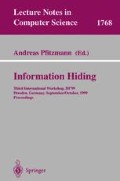Abstract
Traditionally, cryptographic protocols are described as a sequence of steps, in each of which one principal sends a message to another. It is assumed that the fundamental communication primitive is necessarily one-to-one, so protocols addressing anonymity tend to resort to the composition of multiple elementary transmissions in order to frustrate traffic analysis.
This paper builds on a case study, of an anonymous auction between mistrustful principals with no trusted arbitrator, to introduce “anonymous broadcast” as a new protocol building block. This primitive is, in many interesting cases, a more accurate model of what actually happens during transmission. With certain restrictions it can give a particularly efficient implementation technique for many anonymity-related protocols.
Access this chapter
Tax calculation will be finalised at checkout
Purchases are for personal use only
Preview
Unable to display preview. Download preview PDF.
References
Abadi, M., Needham, R.: Prudent engineering practice for cryptographic protocols. Technical Report 125, Digital Equipment Corporation Systems Research Center SRC-125.pdf (June 1994), ftp://ftp.digital.com/pub/DEC/SRC/research-reports/
Anderson, R. (ed.): IH 1996. LNCS, vol. 1174. Springer, Heidelberg (1996)
Bennett, F., Clarke, D., Evans, J.B., Hopper, A., Jones, A., Leask, D.: Piconet: Embedded mobile net- working. IEEE Personal Communications, 4(5):8-15 (October 1997), ftp://ftp.uk.research.att.com/pub/docs/att/tr.97.9.pdf
Blaze, M.: Oblivious key escrow. In: Anderson, pp. 335-343., http://www.crypto.com/papers/netescrow.ps
Chaum, D.: Untraceable electronic mail, return addresses, and digital pseudonyms. Communications of the ACM 24(2), 84–88 (1981), Unofficial copy at http://www.wiwi.uni-frankfurt.de/~kcotoaga/offline/chaum-acm-1981.html
Chaum, D.: The dining cryptographers problem: Unconditional sender and recipient untraceability. Journal of Cryptology 1, 65–75 (1988), Unofficial copy at http://www.scu.edu/SCU/Programs/HighTechLaw/courses/ccp/diningcr.html
Cocks, C.: Split knowledge generation of RSAparameters. In: Darnell, M.J. (ed.) Cryptography and Coding 1997. LNCS, vol. 1355, pp. 89–95. Springer, Heidelberg (1997)
Whitfield Diffie and Martin E. Hellman. New directions in cryptography. IEEE Trans. Inform. Theory, IT-22(6):644-654, November 1976. 437 eBay.
Goldschlag, D.M., Reed, M.G., Syverson, P.F.: iding routing information. Anderson, 137–150
Jackson, I.W.: Who goes here? Confidentiality of location through anonymity. PhD thesis, University of Cambridge (February 1998), http://www.chiark.greenend.org.uk/~ijackson/thesis/
Kuhn, M.G., Anderson, R.J.: Soft tempest: Hidden data transmission using electromagnetic emanations. In: Aucsmith, D. (ed.) IH 1998. LNCS, vol. 1525, pp. 124–142. Springer, Heidelberg (1998)
Pfitzmann, A.: Ein dienstintegriertes digitales Vermittlungs-/Verteilnetz zur Erhohung des Datenschutzes (An IntegratedDigital Services Switching/Distribution Network for Increased Privacy). Technical Report 18/83, Institut fur Informatik IV, University of Karlsruhe (1983)
Pfitzmann, A.: A switched/broadcast ISDN to decrease user observability. In: International Zurich Seminar on Digital Communications, Applications of Source Coding, Zurich, Switzerland, March 6-8 (1984); Swiss Federal Institute of Technology. Proceedings IEEE Catalog no. 84CH1998-4, March 6-8 (1984)
Pfitzmann, A.: How to implement ISDNs without user observability—some remarks. Technical report, Institut fur Informatik, University of Karlsruhe (1985)
Pfitzmann, A.: Diensteintegrierende Kommunikationsnetze mit teil-nehmeruberprufbarem Datenschutz (Integrated services communication networks with end-user verifiable privacy). In: Beech, D., Kugler, H.-J., Stiegler, H., Gram, C., Newman, I., Unger, C. (eds.) Concepts in User Interfaces. LNCS, vol. 234, Springer, Heidelberg (1986)
Pfitzmann, A., Waidner, M.: Networks without user observability. Computers and Security 6(2), 158–166 (1987), http://www.semper.org/sirene/publ/PfWa_86anonyNetze.html
Sandoval, G.: eBay auction goes up in smoke. CNET (September 1999), http://news.cnet.com/news/0-1007-202-123002.html
StockMaster., http://www.stockmaster.com/exe/sm/chart?Symbol=EBAY
Author information
Authors and Affiliations
Editor information
Editors and Affiliations
Rights and permissions
Copyright information
© 2000 Springer-Verlag Berlin Heidelberg
About this paper
Cite this paper
Stajano, F., Anderson, R. (2000). The Cocaine Auction Protocol: On the Power of Anonymous Broadcast. In: Pfitzmann, A. (eds) Information Hiding. IH 1999. Lecture Notes in Computer Science, vol 1768. Springer, Berlin, Heidelberg. https://doi.org/10.1007/10719724_30
Download citation
DOI: https://doi.org/10.1007/10719724_30
Publisher Name: Springer, Berlin, Heidelberg
Print ISBN: 978-3-540-67182-4
Online ISBN: 978-3-540-46514-0
eBook Packages: Springer Book Archive

